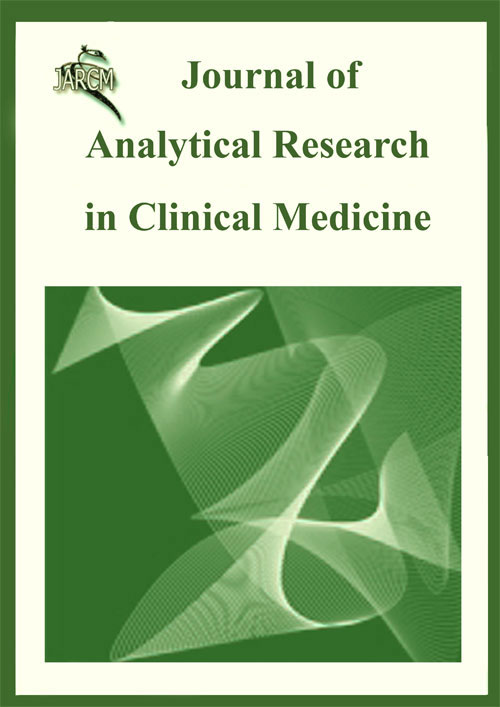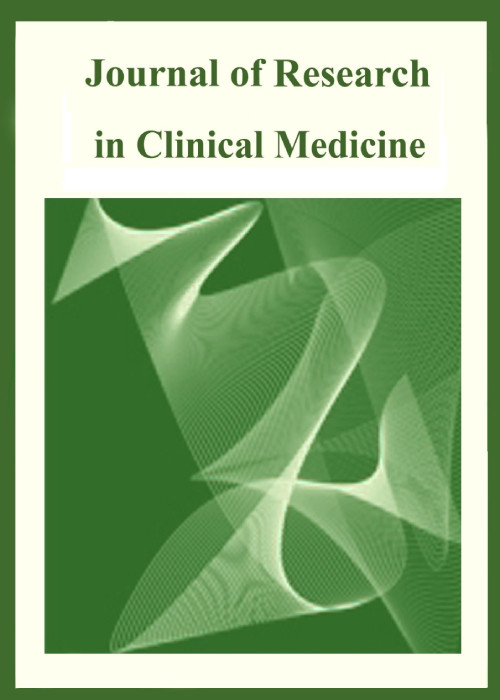فهرست مطالب

Journal of Analytical Research in Clinical Medicine
Volume:7 Issue: 4, Autumn 2019
- تاریخ انتشار: 1398/10/02
- تعداد عناوین: 6
-
Pages 105-109
Different investigations on seasonal variations of the pulmonary thromboembolism and deep vein thrombosis (DVT) incidence have not yielded a definite conclusion. Some papers showed significant increase in incidence of thromboembolism in winter; on the other hand, others neglected that correlation. Some articles have tried to show infrastructure of these variations. Better understanding of the cornerstone of these variations can result in prevention of disease and saving lives of susceptible people. In this narrative review article, we reviewed previous articles according to the region of study and tried to find the factors affecting diverse results among different studies.
Keywords: Thromboembolism, Seasonal Variations, Pulmonary Embolism, Deep Vein Thrombosis -
Pages 110-117Introduction
The risk for coronary artery disease (CAD) and mortality has increased in patients with rheumatoid arthritis (RA). Aspirin has anti-thrombotic effects and causes reduction in CAD occurrence in high-risk individuals. The objective of present project was evaluating the influence of low-dose aspirin on inhibition of platelet aggregation in patients with RA.
MethodsForty-eight subjects with RA diagnosed based on the American College of Rheumatology/European League Against Rheumatism (ACR/EULAR) 2010 criteria and age- and sex-matched healthy participants were studied. All subjects received 81 mg/day aspirin for 10 days. Level of the serum thromboxane B2 (sTxB2), a permanent metabolite of thromboxane A2 (TxA2), was measured before and after therapy using enzyme-linked immunosorbent assay (ELISA) kit. The impotency to decrease sTxB2 production to less than 10 ng/ml indicates suboptimal suppression of platelet aggregation via aspirin.
ResultsLow-dose aspirin decreased sTxB2 significantly compared with baseline in patients with RA [median interquartile range (IQR): 25.72 (11.78, 90.10) to 7.74 (5.80, 8.82), P < 0.001] and in healthy controls [median (IQR): 40.50 (33.25, 50.90) to 7.30 (4.75, 8.85), P < 0.001]. No remarkable changes were seen in sTxB2 between patients and controls after adjustment (P > 0.050). Pharmacologic influence of aspirin was suboptimal in 6.25% of cases in the presence of higher erythrocyte sedimentation rate (ESR) and in 2.7% of controls. Low-dose aspirin decreased sTxB2 significantly only in patients with Framingham Risk Score (FRS) < 10%.
ConclusionLow-dose aspirin decreased sTxB2 level and suppressed platelet aggregation and therefore, was effective in primary prevention of cardiovascular (CV) events in patients with RA; however, additional studies are required to reach accurate conclusions.
Keywords: Aspirin, Thromboxane B2, Platelet Aggregation, Coronary Artery Disease, Rheumatoid Arthritis -
Pages 118-121Introduction
Allopurinol could decrease the undesirable effects of free radicals and then prevent contrast induced nephropathy (CIN). Therefore, it may be useful for reducing the ischemia-reperfusion induced nephropathy and inhibiting nitric oxide synthesis produced in CIN. This study was performed aimeing to determine the effect of allopurinol in the prevention of CIN in patients undergoing angioplasty.
MethodsIn this randomized clinical trial, 100 patients (50 cases as the intervention group receiving allopurinol 300 mg one day and one hour before angiography and 50 cases as the control group) were evaluated. CIN was considered if the serum creatinine (SCr) value was increased 25% in relation to its basic value. Additionally, the prevalence of CIN was evaluated.
ResultsThe case and control groups had CIN 38% and 12%, respectively (P = 0.003). Hyperuricemia was significant indicator of higher CIN rate in the control group (37.5% versus 7.1%) (P = 0.044).
ConclusionFinally, the administration of allopurinol before procedure might prevent CIN following elective percutaneous coronary intervention (PCI) and decrease the rate of CIN.
Keywords: Percutaneous Coronary Intervention, Allopurinol, Angioplasty -
Pages 122-128Introduction
Do Not Resuscitate (DNR) order has been studied ethically, legally, and religiously in different countries after presentation by the American Medical Association (AMA) in 1974. This study was conducted to investigate the attitude of nurses in intensive care units (ICUs) of hospitals of Tabriz University of Medical Sciences, Tabriz, Iran, towards DNR order.
Methods255 nurses working in ICUs were included in a descriptive-analytical study at Tabriz University of Medical Sciences in 2018. The utilized checklist contained two sections: demographic information and 11 questions with a 5-point Likert scale about the attitude towards the DNR order. The scores relating to each question were collected and analyzed.
ResultsThe average of the total score of the questionnaire was 29.97 8.39. The attitudes of participants were negative in all questions except for the 8th and 11th questions. The total score of the questionnaire was 29.49 8.09 in the group with work experience of 15 years and less and 32.49 9.50 (P = 0.036) in the group with a more than 15 years of work experience; which indicates more positive attitude towards the DNR order in individuals with more work experience.
ConclusionThe results showed that in general, the participant nurses did not have positive attitudes concerning the DNR order; however, people with more than 15 years of work experience had more positive attitude towards this order and the investigation of this factor and the causes of its impact on the change of people’s attitude should be carried out in further studies.
Keywords: Cardiopulmonary Resuscitation, Nurses, Attitude -
Pages 129-132Introduction
Intraneural ganglion cysts (INGCs) are an infrequent cause of foot drop. INGCs are benign mucinous cysts within the epineurium of peripheral nerves, which are usually observed in the peroneal nerve at the knee typically leading to symptoms and signs of peripheral neuropathy. Case Report: A 40-year-old man with foot drop who had undergone a spinal study for discopathy was examined in this study. The patient had peroneal nerve compression at the neck of the fibula resulting from an extra neural cyst. Surgical exploration revealed an intraneural cyst. Epineurium was incised and the cyst was evacuated. In a two-week post-surgery follow up, his foot drop had improved partially and the remainder of his symptoms resolved.
ConclusionAwareness of the intraneural cysts of peroneal nerve as a cause for foot drop is important because early surgical intervention could reverse the course of disease.
Keywords: Peroneal neuropathy, Intraneural cyst, Peroneal nerve palsy


